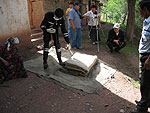NATO Science for Peace Project clears radioactive waste in Kyrgyzstan

Measuring levels of radiation in cloths to separate radioactive from non-radioactive materials
Photo courtesy of Dr. Peter Stegnar, Jozef Stefan Institute, Ljubljana, Slovenia.)
In June 2008 a NATO Science for Peace (SfP) project helped with the collection
and removal of around 100 kg of radioactive waste from the Minkush settlement in Kyrgyzstan.
The problem in Minkush dates back to the late sixties, when local inhabitants took radioactive filtration cloths from a former uranium mill plant for use in their homes. They were totally unaware of the high doses of ionizing radiation deriving from these materials. In many cases, contact gamma dose rates exceeded levels of 50 uSv/h (microsieverts per hour), which could result in substantially high radiation doses (several hundred mSv per year) for individuals and their family members who had been using these materials for an extended period of time.
In order to protect the people from further exposure, a NATO SfP remediation project was initiated with experts from Slovenia and Kyrgyzstan, who jointly with the Ministry of Ecology and Emergencies, the Ministry of Health and the Chu Ecological Laboratory, carried out collection, appropriate packaging and transfer of around 100 kg of radioactive materials from Minkush to a central national depository for radioactive waste near Bishkek.
The entire process was conducted in compliance with national and international standards for radioactive waste management and was implemented by certified radiation workers from Kyrgyzstan.
This project is part of a broader NATO SfP Project on Uranium Legacy and Environmental Security in Central Asia. More information is available at www.nato.int/issues/science-environmental-security/projects/5/index.html
